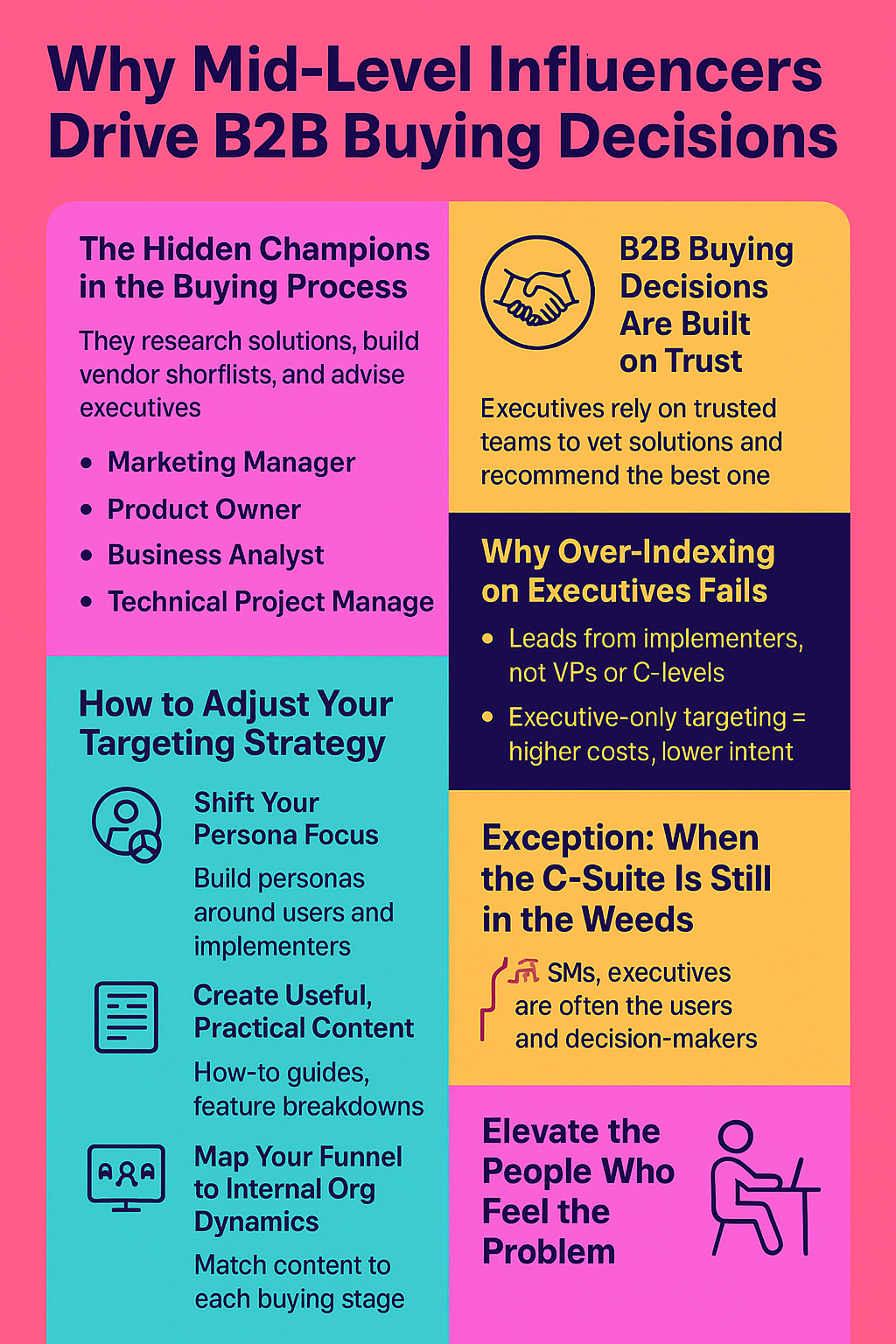In B2B marketing, there’s a long-standing obsession with targeting “the decision-maker.” Most campaigns are optimized for clicks from VPs, C-level executives, and founders. It’s easy to understand why—on paper, these are the people with the budget and authority to say yes. But in reality, especially when selling into mid-market or enterprise organizations, these individuals are rarely the ones initiating the buying process. They’re often not even the ones evaluating your product.
If you want better outcomes from your marketing campaigns, it’s time to reframe how you think about B2B buying decisions. You need to focus on the people closest to the pain—not just the ones with the authority to sign.
The Hidden Champions in the Buying Process
In most organizations, it’s not the executive who’s Googling “how to streamline reporting workflows” or downloading whitepapers about marketing attribution platforms. It’s the marketing ops manager. It’s the product analyst. It’s the IT lead tasked with solving the problem.
These roles often go by titles like:
- Marketing Manager
- Product Owner
- Business Analyst
- Technical Project Manager
They’re not flashy, but they’re functional. And in many B2B buying decisions, they are the ones doing the research, building the shortlist of vendors, and recommending a solution up the chain.
Here’s how the typical flow works:
- Pain is felt – A workflow is broken, a process is inefficient, or a tool is failing.
- Research begins – The person closest to the issue starts exploring solutions.
- Options are discussed internally – The internal team evaluates tradeoffs and aligns on what to pursue.
- The decision is escalated – A recommendation is made to a VP or executive.
- The decision-maker approves – But only after trusting the recommendation from the team.
If your content, ads, and messaging are only aimed at the last person in this chain, you’re missing all the influence points that led to the final yes.
B2B Buying Decisions Are Built on Trust
Executives don’t operate in a vacuum. They surround themselves with people they trust. The larger the organization, the more true this becomes. Executives don’t have time to personally research every software, vendor, or service option—they rely on their teams to vet solutions and bring them forward.
If you’ve ever had sales conversations that suddenly died after the VP “went dark,” chances are your messaging didn’t give their team enough confidence to advocate for your product internally.
That’s why successful B2B marketers build trust with the evaluator—not just the end decision-maker.
Why Over-Indexing on Executives Fails
Let’s look at real data. In an internal analysis of high-intent inbound leads for a mid-market SaaS company:
- 0% of inbound leads came from VP or C-level executives.
- When filtering by leads tied to opportunities? Still 0% at the VP/C-level.
Instead, every lead came from someone in a hands-on role—marketing specialists, implementation managers, CRM admins. These were the people:
- Searching Google for specific problem-based queries
- Reading feature comparisons and integrations
- Watching product demos to evaluate fit
Yet, many marketers continue to spend the majority of their ad budgets targeting only executives. Why? Because it feels “strategic.” But in practice, it just leads to higher CPMs and lower intent.
How to Adjust Your Targeting Strategy
To align your strategy with real-world B2B buying decisions, make these changes:
1. Shift Your Persona Focus
Build buyer personas around users and implementers, not just budget holders. What do they care about? What problems do they experience day-to-day? What language do they use to describe those problems?
2. Create Useful, Practical Content
Content that helps someone solve a real problem will always perform better than generic “industry insights” meant to appeal to an executive. Think:
- How-to guides
- Feature breakdowns
- Integration tutorials
- Case studies with clear operational outcomes
3. Diversify Paid Media Targeting
Yes, you can still target the C-suite. But don’t over-index. Build separate ad sets for job titles like “Manager,” “Specialist,” “Coordinator,” and “Lead.” In many platforms (especially LinkedIn), these audiences are cheaper to reach and more likely to engage.
4. Map Your Funnel to Internal Org Dynamics
Treat your funnel like their internal process. Your top-of-funnel content should help someone understand the problem. Mid-funnel should equip them to evaluate vendors. Bottom-of-funnel should help them justify the decision upward.
Exception: When the C-Suite Is Still in the Weeds
There is one major exception to this model: SMBs. In small businesses, the C-level is the user, the evaluator, and the decision-maker—sometimes all in one person. When the company is 5, 10, or even 25 people, the CEO is often the one directly feeling the pain.
In those cases, targeting the executive makes sense. But even then, your message should still speak to the problem being felt—not just high-level outcomes.
Smart Targeting = Higher Conversion Rates
By aligning your marketing efforts with actual B2B buying decisions, you’re not just getting more qualified traffic—you’re building momentum inside the organization. You’re enabling your champion to bring your product to their boss and say, “This is the tool we need.”
You win not because your CEO-facing landing page dazzled them, but because someone deep in the workflow felt seen, understood, and supported.
Conclusion: Elevate the People Who Feel the Problem
Don’t ignore executives entirely, but don’t make them your sole focus. In most B2B buying decisions, they’re the final yes—not the origin of the buying journey.
The people closest to the problem are the ones doing the research, shaping internal narratives, and shortlisting vendors. Speak to them. Build content for them. Target them.
They’re not just influencers—they’re the foundation of every B2B sale.


Hi there! I’m Scott, and I am the principal consultant and thought leader behind Stratus Analytics. I have a Master of Science degree in marketing analytics, and I’ve have been providing freelance digital marketing services for over 20 years. Additionally, I have written several books on marketing which you can find here on Amazon or this website.
DISCLAIMER: Due to my work in the packaging industry, I cannot take on freelance clients within the packaging manufacturing space. I do not want to provide disservice to your vision or my employer. Thank you for understanding.
